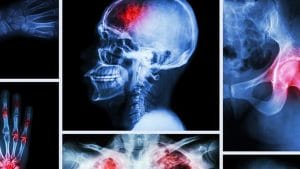Table of Contents
This article will discuss the history of nuclear medicine in the Philippines, various procedures, safety and risks, Positron Emission Tomography (PET scan), different kinds of nuclear medicine scans, and common tests for diagnostics and treatments.
What is Nuclear Medicine?
Nuclear medicine is a medical specialty that uses radiation to diagnose and treat diseases.
Nuclear medicine scans use a small amount of radioactive material, called a tracer, to help doctors see how your body is working.
The tracer is injected into a vein or swallowed. It travels through your body, giving off signals and detection using a special scanner.
The scanner creates pictures of the inside of your body that can show problems such as tumors, infection, or blocked blood vessels.
Brief History
Nuclear medicine is a relatively new medical specialty that uses radioactive materials to diagnose and treat diseases. Although the use of radiation in medicine dates back to the late 1800s, nuclear medicine did not become a recognized specialty until the 1950s. In the early days of nuclear medicine, scientists used radioactive materials to diagnose and treat thyroid diseases and cancer. In recent years, nuclear medicine can diagnose and treat a wide variety of diseases, including heart disease, stroke, and Alzheimer’s disease.
Nuclear Medicine in the Philippines
Nuclear Medicine in the Philippines is a specialization that began with the opening of the radioisotope research laboratory at the Philippine General Hospital in 1956 under the leadership of Dr. Paulo C. Campos. As they were originally called, nuclear medicine scientists consisted of radiologists, pathologists, as well as internists that went through either short preceptorship abroad or formal training in nuclear medicine at university clinical centers. They used 131I HAS, 51Cr-tagged red blood cells, 131I-triolein-oleic acid, and also 60Co-vitamin B12 for analysis functions and also 131I and also 32P for restorative objectives.
In 1966, the Nuclear Medicine in the Philippines researchers developed the Philippine Society of Nuclear Medicine (PSNM), with Dr. Paterno C. Chikiamco serving as its very first president. PSNM came to be the third nuclear medicine culture in Asia, after South Korea and Japan. Also, in its early years, PSNM’s duty in the region was already identified as it turned into one of the founding members of the Asian Federation of Nuclear Medicine in 1969.
During that time, PSNM had already created close ties with the Philippine Atomic Energy Commission (until it was restructured in 1986 to end up being the present Philippine Nuclear Research Institute or PNRI). The International Atomic Energy Agency (IAEA) played a crucial function in the personnel advancement of these pioneering Filipino physicians. They would undoubtedly get research to train in recognized Nuclear Medicine organizations abroad.
By the end of the initial years of the PSNM, numerous nuclear medicine centers had been established in Manila, every one of which had rectilinear scanners as their leading imaging equipment. The John F. Cotton Memorial Hospital had installed the country’s first gamma cam.
Nuclear Medicine in the Philippines is a specialized high-facility and high-maintenance diagnostic and treatment using state-of-the-art scanning technology integrated with radiology. Since the procedure involves the element radiation, it has the full attention and supervision of government departments and investment from private corporations. As they were initially called, nuclear medicine researchers were composed of pathologists, internists, and radiologists who undertook either brief preceptorship abroad or formal training in nuclear medicine at university clinical.
Source: NCBI
List of Hospitals with Nuclear Medicine in the Philippines
Here are a list of Nuclear Medicine doctors and hospitals in the Philippines
- Makati Medical Center
- Philippine Heart Center
- Jose Reyes Memorial Medical Center
- University of Santo Tomas Hospital
- Cardinal Santos Medical Center
- St. Luke’s Medical Center – Quezon City
- St. Luke’s Medical Center – Global City
- National Kidney and Transplatn Institute
- Rizal Medical Center
- Manila Doctors Hospital
- Asian Hospital and Medical Center
- The Medical City
How are Nuclear Medicine Scans Done?
When someone has a problem with their health, they often go to the doctor for a scan. There are many different types of scans, but one of the most common is a nuclear medicine scan. This type of scan uses radioactive materials to create images of the inside of the body.
The radioactive material is usually injected into the person’s bloodstream, and it can also be swallowed or inhaled. After scanning, images capture the radioactive material as it travels through the body.
A nuclear medicine scan is a medical imaging technique that uses small amounts of radioactive material to diagnose and treat a variety of diseases, including cancer. The radioactive material is usually injected into the bloodstream.
The material accumulates in the organ or area of the body. A scanner then detects radioactivity and produces images that help doctors diagnose and treat illness.
Common Tests of Nuclear Medicine Include:
Renal scans
Renal scans are common tests of nuclear medicine. The test can help to determine how well the kidneys are functioning and whether there is any damage to the kidneys. The scan uses a radioactive substance that is injected into the bloodstream. The substance travels to the kidneys and is absorbed by the cells. A scanner is used to create images of the kidneys that can be analyzed to determine how well they are working.
Thyroid scans
Nuclear medicine tests are standard exams used to help diagnose and treat a variety of medical conditions. One such test is a thyroid scan, which is used to determine how well the thyroid gland is functioning. The scan uses a small amount of radioactive material called a tracer, which is injected into the patient’s bloodstream. The tracer accumulates in the thyroid gland and is detected by a special camera that produces images of the gland.
Bone scans
Bone scans are a standard nuclear medicine test that is used to diagnose and monitor bone diseases. The test uses a small amount of radioactive material, called a tracer, to help visualize bones on a scan. There are several types of bone scans, but all use the tracer to show how much activity is happening in the bones. This can help doctors determine if there is a problem with the bones, such as cancer, infection, or fracture.
Gallium scans
Gallium scans are a standard nuclear medicine test used to evaluate inflammation and infection. The scan uses a radioactive isotope of gallium that is absorbed by white blood cells. Areas of increased inflammation and infection will show up as bright spots on the scan. Gallium scans can be used to help diagnose conditions such as sepsis, abscesses, and pneumonia.
Heart scans
Heart scans are a standard test of nuclear medicine. The scans use radioactive materials called tracers to create images of the heart that can help doctors diagnose and treat heart disease. There are two types of heart scans: stress tests and coronary angiograms. Stress tests are used to see how well the heart handles exercise. Coronary angiograms are used to see how well the blood vessels that supply the heart are working.
Brain scans
Nuclear medicine is a branch of medical imaging that uses small amounts of radioactive material to diagnose and treat diseases. A variety of tests are used in nuclear medicine, including brain scans. Brain scans can help doctors determine the cause of neurological problems, such as seizures or strokes. They can also help doctors track the progress of treatments for conditions such as Alzheimer’s disease and brain tumors.
What You Should Know
The most common use of nuclear medicine is to diagnose problems with the heart and lungs.
Nuclear medicine can also be used to treat cancer and other diseases.
The radiation from nuclear medicine treatments is shallow dose and poses no health risks to patients.
Nuclear medicine is a safe and effective way to diagnose and treat many medical conditions.
What To Expect
Some of the most common applications of nuclear medicine include: detecting cancer, evaluating heart function, and diagnosing thyroid disorders.
Nuclear medicine has the ability to change a patient’s health condition in a very short amount of time.
The radiation emitted by nuclear medicine can be detected with a special camera, which shows the image on a screen or monitor that could be moved around and observed.
Benefits and Risks of Nuclear Medicine
The benefits of nuclear medicine include:
- The main benefit of nuclear medicine is that it helps physicians diagnose and treat diseases non-invasive.
-
Nuclear medicine can help determine the best treatment options for a patient.
-
The ability to change a patient’s health condition in a very short amount of time.
-
Nuclear medicine makes it possible to treat a variety of diseases and conditions, including cancer and heart disease.
-
Nuclear medicine can help identify problem areas in the body.
-
Nuclear medicine can aid in the prevention of diseases such as cancer and heart disease.
https://www.youtube.com/watch?v=rZ_cj8qYKBo
Risks of Nuclear Medicine in the Philippines:
- Radiation exposure is the chief risk associated with nuclear medicine. While radiation exposure can cause serious health problems, it is usually manageable if the staff and management are implementing precautions.
-
Another risk associated with nuclear medicine is the potential for a nuclear accident.
-
The most common side effect of nuclear medicine is pain.
-
The risk of organ damage is also a concern.
-
The radioactive materials used in nuclear medicine can affect the environment around them, possibly contaminating groundwater or making their way into the air.
Procedures of Nuclear Medicine in the Philippines?
Nuclear medicine procedures are a type of medical imaging that uses small amounts of radioactive material to diagnose and treat diseases. The material is usually injected into a vein or swallowed. Imaging equipment then detects the radiation as it moves through the body. This allows doctors to see how organs and tissues are working. Nuclear medicine procedures can help diagnose problems such as infection, cancer, heart disease, and thyroid disorders.
One of the most common uses of nuclear medicine is to diagnose heart problems. Other common uses of nuclear medicine include diagnosing cancer and thyroid problems. Nuclear medicine procedures use this technology to treat cancer and other medical conditions.
Nuclear medicine procedures are safe and relatively painless.
What are Radioactive Materials?
Nuclear medicine uses radioactive materials to diagnose and treat diseases. These materials, called radionuclides, emit radiation that unique cameras can detect. This radiation can capture the images of organs and tissues or treat tumors.
Health Effects with Procedures of Nuclear Medicine in the Philippines?
According to the National Council on Radiation Protection and Measurements, nuclear medicine procedures have no known significant health effects. In the Philippines Medical Association, Nuclear Medicine in the Philippines is of the highest standard and can be compared to the standards of UK, USA, Japan, France, and Germany.
While a person is exposed to a small amount of radiation during a nuclear medicine procedure, the dose is considered safe. In fact, the radiation exposure from a nuclear medicine procedure is about the same as that received from a chest x-ray.
What are some standard nuclear medicine procedures?
What is Positron Emission Tomography (PET scanning)
Positron emission tomography, also known as PET scanning, is a medical imaging technique used to diagnose various conditions.
A PET scan uses a small amount of radioactive material that is injected into the patient’s bloodstream.
The radioactive material emits positrons, which are then detected by the scanner. The scanner creates a three-dimensional image of the inside of the body that can be used to diagnose a variety of conditions.
How is Positron Emission Tomography (PET) scans used?
PET scans can diagnose and treat medical conditions. The scans use a small amount of radioactive material that is injected into the patient’s body. The material collects in different organs and tissues. A scanner then measures the radiation emitted by the material. This information is used to create images of the inside of the body. PET scans can be used to detect cancer, heart disease, and other medical conditions.
Diagnostic Procedures
PET scans are a diagnostic procedure used to examine the body for signs of disease. A PET scan uses a radioactive tracer to create images of the body’s organs and tissues. The tracer is injected into the patient’s bloodstream and collects in organs and tissues. A scanner then constructs images of the tracer as it emits positrons. These images can help doctors diagnose a variety of diseases, including cancer, heart disease, and Alzheimer’s disease.
Therapeutic Procedures
PET scans are a type of nuclear medicine scan that uses a small amount of radioactive material to help diagnose and treat diseases. The radioactive material is injected into the patient’s bloodstream and travels to the part of the body. A scanner then detects radioactivity and creates images that show how the body is working. PET scans can help diagnose problems such as cancer, heart disease, and brain disorders. They can also be used to help plan radiation therapy for cancer patients.
The Future Direction of Nuclear Medicine in the Philippines
Nuclear Medicine in the Philippines is constantly evolving and improving with the help of private corporations, government bodies, and non-profit organizations.
The field has seen a number of recent breakthroughs that will change the way doctors utilize this technology in future diagnostics and treatments. Some of these innovations include new imaging techniques and the development of targeted radiation therapies.
These advancements are likely to improve the accuracy and effectiveness of nuclear medicine treatments and could help to make them more accessible to patients.
Conclusion: Nuclear Medicine in the Philippines
In conclusion, nuclear medicine in the Philippines is a safe and effective way to diagnose and treat various medical conditions.
It is essential to understand the different procedures and safety precautions involved in order to ensure a positive experience.
If you are considering having a nuclear medicine scan, be sure to talk to your doctor about which test is proper for you.














